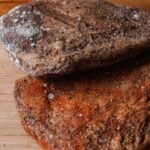Guanciale - Dry Cured (Equilibrium)
One of the most classic's from Italy, Guanciale is the salt dry cured jowl of a quality pig. Using quality pork from a well-fed, older animal jowl of the pig is used, boneless and often triangular in shape (could be 1-3kg / 2-6 lbs). One of the most versatile Italian's classic dry cured meats. It's used in many Italian dishes or can be served as a antipasti/charcuterie board.
Ingredients
- 1000 g Qualit Pig Jowl (Inside Cheek)
- 22.5 g Salt (2.25% of meat weight)
- 5 g Black Peppercorns (0.5% of meat weight)
- 2.5 g Pink Curing Salt No. 2 (Prague Powder #2, Instacure #2, many other names - To be used for over 30 days meat curing projects (0.25% of meat weight) Optional See Notes
Instructions
Curing Steps
-
Trim to the desired shape. Skin is left on. Carefully remove glands on meat.
-
Weigh the meat accurately, record weight
-
Calculate or Use the Recipe Above to Auto-calculate the Salt and Spices
-
Use a Mortar and Pestle or Spice Grinder to mix the salt and spices. Mix salt, spices, and optional curing agents thoroughly, ensuring even distribution in the cure.
-
In a large bowl or tray rub and cover the meat with the salt and spices (it will seem like not much, but this is enough of the cure)
-
Apply the Cure: Coat the meat with the curing mixture, ensuring all surfaces are covered, including crevices in the meat.
-
Place the meat and all the salt cure mixture into a sealable bag- options include vacuum bags, zip lock bags etc.
-
Remove From Bag
Hanging and Drying Steps
-
Optionally, apply additional spices or aromatics before hanging - ie. chili, peppercorns
-
Hang in a Suitable Environment. Often 50-60°F / 10-50°C. Humdity of 70-80% ideally. Make a hole with a knife for either a S hook or some butcher twine. Hang the meat in a cool, well-ventilated Area, Cellar, Garage, DIY Curing Chamber, Regular Fridge, Dry Curing Chamber
-
Monitor Progress: Regularly check the meat’s weight and appearance to gauge the curing process’s progression. Vinegar dabbed onto mold can remove it, if excessive growth occurs.
-
Achieve weight loss of a minimum 30%, ideally 35-40%. However, large fat amounts have less water in regards to Weight loss.
Recipe Notes
Please note that the craft of making dry-cured meats is beyond a recipe. This is not a cooked product. It takes a reasonable amount of knowledge to create salumi, charcuterie, and salami safely.
My advice is if you have doubts about smell or visual cues, then it's not worth eating.
This is my interpretation of a classic salumi whole muscle dry cured meat project.
- Hang the meat in a suitable environment, ensuring proper airflow and humidity levels for optimal drying.
- For small amounts under 300 grams, you can dry the meat on a non-reactive rack in a regular fridge. However, the outcomes will be far from ideal.
- If fuzzy or powdery white mold develops, you must use your senses to assess it. Here is an article about mold in detail.
- Pink Curing salt is an optional ingredient - please carefully read this other article I've written about this.
- If you want to build a DIY dry chamber, I've written extensively on the topic here.
- Always complete the drying before consumption.
- Uneven drying is always an issue when making dry-cured meats after weight loss is complete. Removing the mold with vinegar, leaving it to dry in a regular fridge, and then vacuum packing for 4-8 weeks can equalize the meat moisture evenly.
